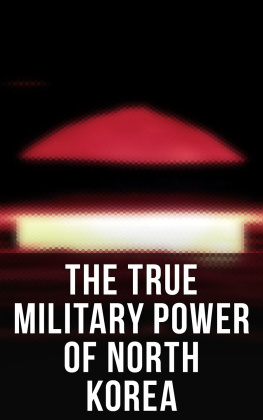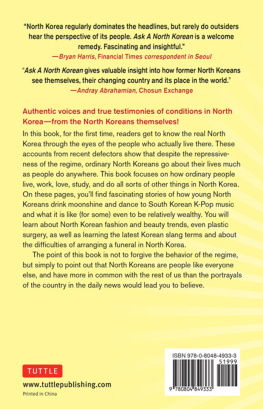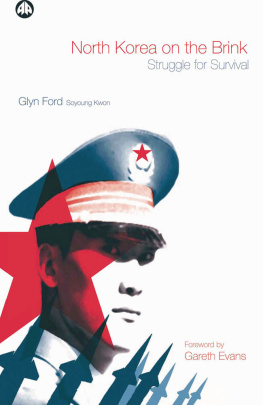North Korea in a Nutshell
North Korea in a Nutshell
A Contemporary Overview
Kongdan Oh and Ralph Hassig
ROWMAN & LITTLEFIELD
Lanham Boulder New York London
Published by Rowman & Littlefield
An imprint of The Rowman & Littlefield Publishing Group, Inc.
4501 Forbes Boulevard, Suite 200, Lanham, Maryland 20706
https://rowman.com
6 Tinworth Street, London SE11 5AL, United Kingdom
Copyright 2021 by Kongdan Oh and Ralph Hassig
All rights reserved. No part of this book may be reproduced in any form or by any electronic or mechanical means, including information storage and retrieval systems, without written permission from the publisher, except by a reviewer who may quote passages in a review.
British Library Cataloguing in Publication Information Available
Library of Congress Cataloging-in-Publication Data
Names: Oh, Kong Dan, author. | Hassig, Ralph C., author.
Title: North Korea in a nutshell : a contemporary overview / Kongdan Oh and Ralph Hassig.
Description: Lanham, Maryland : Rowman & Littlefield, [2021] | Includes bibliographical references and index.
Identifiers: LCCN 2020051583 (print) | LCCN 2020051584 (ebook) | ISBN9781538151389 (Hardcover : acid-free paper) | ISBN 9781538151396 (ePub)
Subjects: LCSH: Korea (North)Politics and government2011- | Korea (North)Politics and government1994-2011. | Kim, Chong-un,1984Influence. | Kim, Chong-il, 1942-2011Influence. | Kim, Dae Jung, 1925-2009Influence. | Korea (North)Military policy. | Korea (North)Economic conditions. | Korea (North)Social life and customs.
Classification: LCC JQ1729.5.A58 O5 2021 (print) | LCC JQ1729.5.A58 (ebook) | DDC 951.9304dc23
LC record available at https://lccn.loc.gov/2020051583
LC ebook record available at https://lccn.loc.gov/2020051584
 TM The paper used in this publication meets the minimum requirements of American National Standard for Information Sciences Permanence of Paper for Printed Library Materials, ANSI/NISO Z39.48-1992.
TM The paper used in this publication meets the minimum requirements of American National Standard for Information Sciences Permanence of Paper for Printed Library Materials, ANSI/NISO Z39.48-1992.
Preface
The first author of this book, Kongdan Oh, has been studying North Korea for almost four decades. In 1981, while a graduate student at Berkeley, she was hired by one of her professors to read documents on North Korea. This was no stretch for her because she grew up in South Korea, and her parents had come down from North Korea when the communists took over in 1945. After graduate school, she joined a think tank, where she conducted research on East Asian security affairs, which prominently included North Korea, and she has been engaged in these think tank studies ever since. The second author, Ralph Hassig, is a social psychologist by training, and since he is married to the first author, he began to take an interest in her North Korea work. They both spent an academic year in Europe in the early 1990s, giving Dr. Oh a chance to observe the process of German unification as a possible model for eventual Korean unification. Upon returning to the States, Dr. Hassig became actively involved in North Korea research. And that is how the two of us came to be interested in this strange and exasperating country.
Initially, most of our work dealt in some way with North Korea as a security threat to the United States, especially focusing on North Koreas nuclear weapons program. After the failure of the 1994 Agreed Framework, which the United States fruitlessly hoped would end North Koreas pursuit of nuclear weapons, we started to lose interest in the nuclear issue, which seemed destined to be unresolved for many years to come. Instead, we increasingly turned our attention to the lives of ordinary North Korean people, which were becoming known thanks to the flood of defectors that began arriving in South Korea in the late 1990s. We conducted interviews with some of these defectors and have remained in touch with them, gaining insight about their former lives in North Korea and the lives of their family members who remained behind.
Over ten years ago we came up with the title for this volume, and we liked it so much that we decided we had to write a book to go along with it. After several chapters, we set it aside to write another book, The Hidden People of North Korea: Everyday Life in the Hermit Kingdom. Only recently did we return to Nutshell and begin writing in earnest.
In some respects, this book encapsulates all the subjects we have studied in the course of our long careers, with a few topics added to make it complete. As such, it includes the traditional military-related concerns that have weighed on foreign governments for many years, along with issues relating to how ordinary North Koreans have adapted to life in a relatively harsh physical and social environment. Fifty short topical sections have been collected into nine chapters, which may be read in any order, followed by a conclusion that summarizes the books themes.
To be sure, these sections are but a brief introduction to North Korea; any one of them could easily be expanded to book length, as indeed some have by other authors. When we began our research into North Korea, only a few books on the subject were on the market. Today there are hundreds, written by foreign writers such as ourselves, by South Koreans, and by North Korean defectors. Some books have also been written by North Koreans still living in their country, including dozens of volumes about their leaders, but since these authors are working for their government, their works should be treated as propaganda tracts rather than factual accounts.
A few words about translating Korean into English. The Korean alphabet can be transliterated into Roman letters in several ways. Until 2000, the most common method was to use the McCune-Reischauer system, which is familiar to several generations of Korean scholars and is also used by North Koreans to translate their works into English. We have simplified the system by dispensing with apostrophes (used to indicate aspirated consonants) and diacritical marks above vowels. The resulting simplification will be admirably suited to the needs of most readers. In 2000, South Koreas Ministry of Culture and Tourism introduced Revised Romanization, which has met with some resistance but is now widely adopted in South Korea. However, because it looks somewhat strange to many foreigners, ourselves included, we have chosen to stay closer to the older system.
In Korean, the family name usually comes first, followed by one or two given names. Some Koreans hyphenate their two given names, others write them separately, and some combine the two (for example, the books first author). The official North Korean approach is to write them separately. Thus, in North Korea the names of the three men who have led the country would be written as Kim Il Sung, Kim Jong Il, and Kim Jong Un. However, to make it clear to foreign readers which are the family names and which are the given names, we have decided to use an equally popular approach and hyphenate the given names: Kim Il-sung, Kim Jong-il, and Kim Jong-un. Throughout the book, Korean names are presented in this manner except where Koreans outside of North Korea specifically use another form.
As for pronunciation, especially of the leaders names, Kim (the most popular name in either half of Korea) is pronounced just as it would be in English. Il is pronounced like eel, and sung is pronounced much like the English word. Jong rhymes with
Next page













 TM The paper used in this publication meets the minimum requirements of American National Standard for Information Sciences Permanence of Paper for Printed Library Materials, ANSI/NISO Z39.48-1992.
TM The paper used in this publication meets the minimum requirements of American National Standard for Information Sciences Permanence of Paper for Printed Library Materials, ANSI/NISO Z39.48-1992.